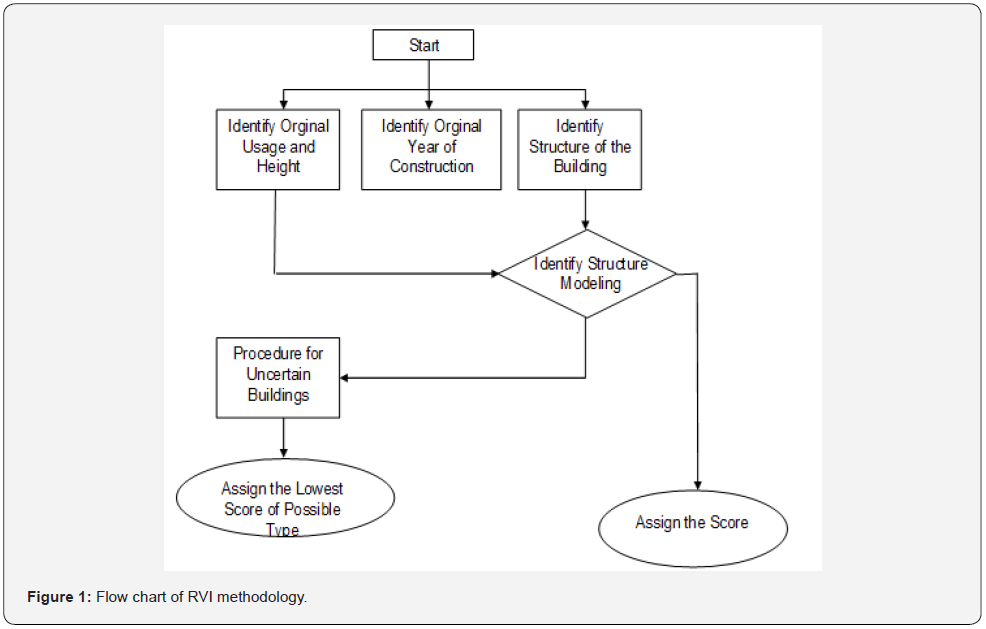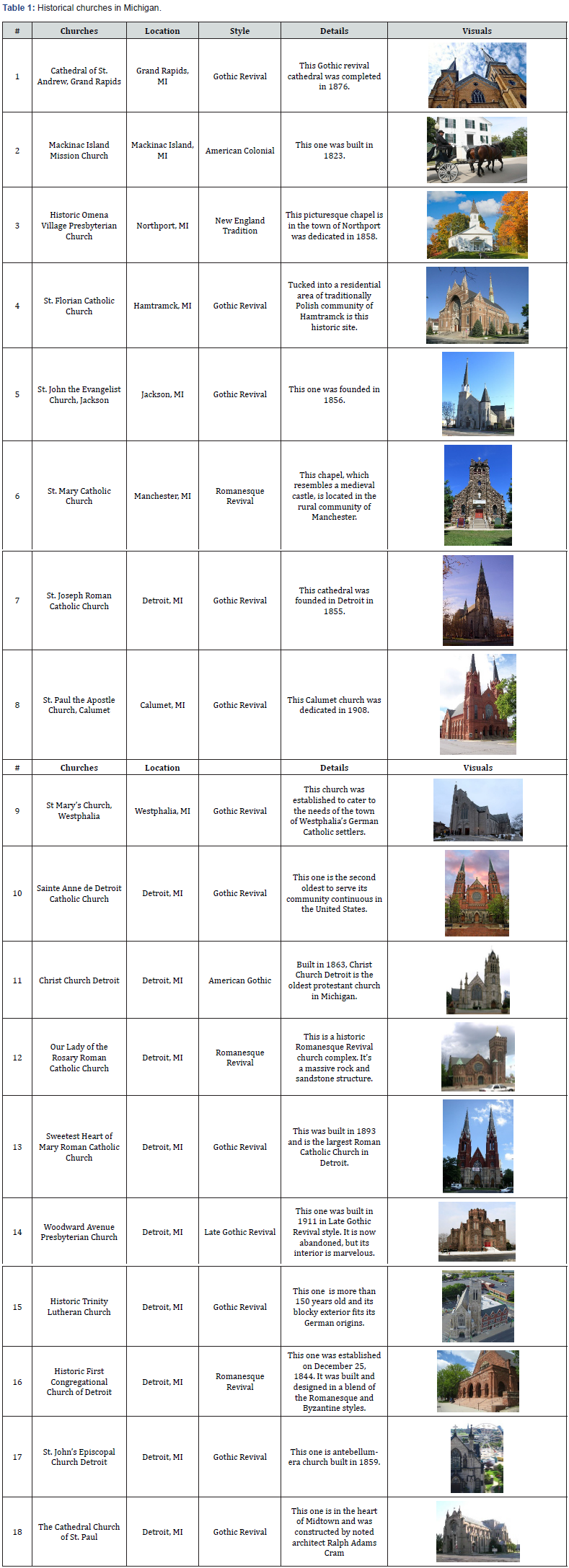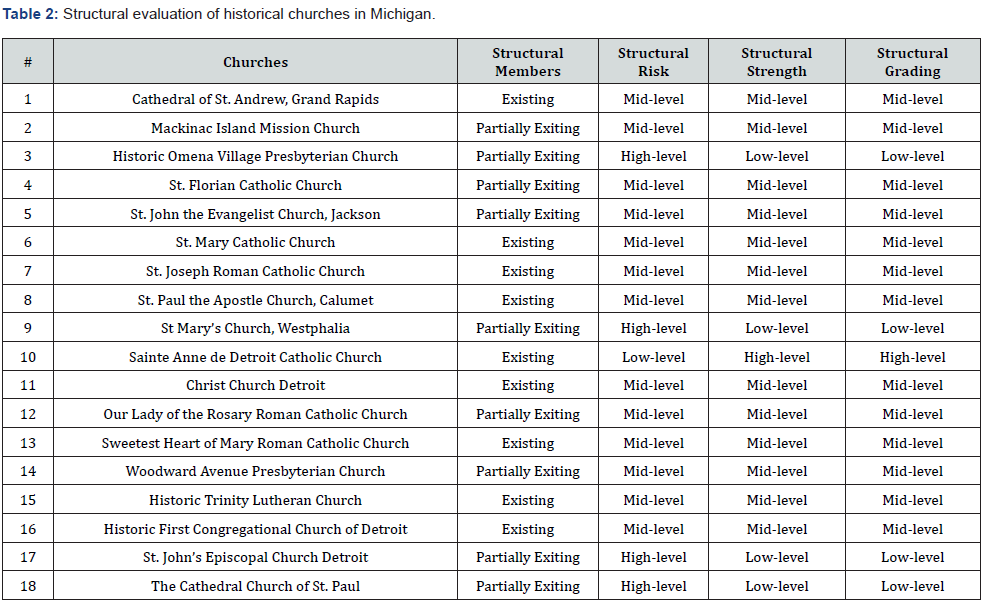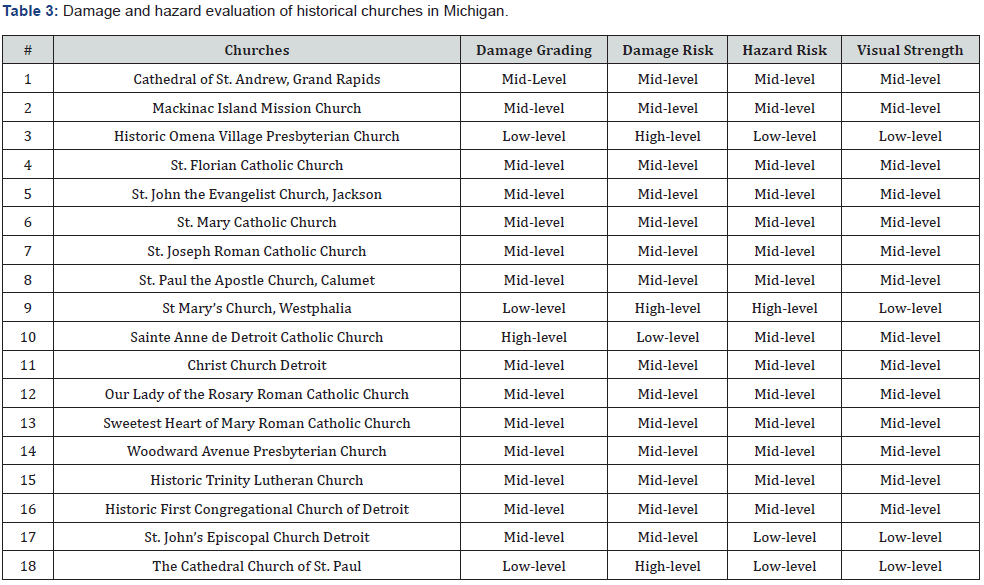A Systematic Investigation of Historical Churches in Michigan, USA
Kasim Korkmaz*
College of Engineering and Technology, Eastern Michigan University, USA
Submission: November 24, 2022; Published: December 12, 2022
*Corresponding Author: Kasim Korkmaz, College of Engineering and Technology, Eastern Michigan University, USA
How to cite this article:Kasim Korkmaz. A Systematic Investigation of Historical Churches in Michigan, USA. Civil Eng Res J. 2022; 13(3): 555865. DOI 10.19080/CERJ.2022.13.555865
Abstract
Michigan is very rich with an abundance of historical churches listed in the National Register of Historic Places including the second oldest Catholic parish in the nation. These historical churches reflect the city’s multicultural nature with their alluring architecture and offer a crucial socio-cultural involvement in extreme events as broadly observed during the pandemic period. On the other hand, Michigan is also prone to disasters such as hurricanes, tornadoes, and fires. The last flood in May 2020 resulted in dam failures and caused severe damage in Midland, Michigan. Therefore, preservation planning is urgently needed to be prepared for such extreme events including climate-related flooding. The research work investigates the historical churches in Michigan and their structural resistance to a possible natural disaster. In the research, a rapid visual inspection approach and FEMA methodology were used in combination to ensure the safety of historical churches for disaster preparedness. A structural investigation procedure was carried out for eighteen historical churches in Michigan to understand the current structural status of the historical churches. The churches were selected based on their historical characteristics. Selected churches are also the famous ones in Michigan. As a result of the carried investigation process, structural capacities, structural responses, damage risks, and hazard risks of the historical churches were defined. Structural capacities were defined with the target to increase resilience for the recovery, rebuild, and preparation for possible future disasters.
Keywords: Historical churches; Michigan; Structural assessment; Rapid investigation
Opinion
Michigan is one of the historically rich states in the US. Besides its natural beauty, there is an enormous number of historic churches in Michigan recognized by the National Register of Historic Places. One of these churches is the second oldest Catholic parish in the nation. Historical churches in Michigan reflect the city’s multicultural nature with their alluring architecture and offer a crucial socio-cultural involvement in extreme events as broadly observed during the pandemic period. These churches are still active and in-service for Michiganders. Especially the ones in Detroit are well known and attractive for the touristic activities. After a long period of an economic crisis in Detroit started in 2008, the city has been turning back to its good old days. People living in the houses got damaged by various extreme events and disasters may need help and assistance to reduce the impact of disasters during and after the disasters. Given the socio-cultural involvement of these faith-based organizations within local communities, they play a pivotal role in society. They reduce community vulnerability by offering resources and providing services to the community members in such difficult times. It became more apparent during the pandemic period. However, for them to serve as a hub of community resilience against disasters, they need to have buildings that are resilient. Therefore, the present research emphasizes keeping those buildings safe.
On the other hand, Michigan is also prone to disasters such as hurricanes, tornadoes, and fires. One of the last disasters in Michigan was the flood in May 2020, which resulted in dam failures and caused severe damage in Midland, Michigan. Therefore, preservation planning is urgently needed to be prepared for such extreme events including climate-related flooding. With this background, it is seen that there is a huge need for preservation planning. Detailed planning and countermeasure approach within the forecasting is urgently needed to be prepared for natural disasters. With the climate change problem, natural disasters all around the world including in the US and Michigan have increased over the years. Therefore, planning should also cover the climate change issues and flooding related to climate change.
The present research work investigates the historical churches in Michigan and their structural resistance to a possible natural disaster. In the research, the historical churches in Michigan listed on the National Register of Historic Places will be investigated and a rapid structural investigation approach and FEMA methodology were used in combination to ensure the safety of historical churches for disaster preparedness. Structural capacities of the buildings were determined and targeted to increase resilience as these buildings recover, rebuild, and prepare for possible future disasters. The motivation of the research is also supported by the fact that the climate across the globe is changing considerably, and the future climatic paradigm is anticipated to be different from the current expectations of the climate. The impacts of the changing climatic paradigm have been felt across the U.S., and the country has been impacted by more frequent natural disasters.
Methodology
In the present research, a practical approach was applied to investigate the historical churches in Michigan. Rapid Visual Inspection (RVI) methodology from ATC 21 was carried out for the historical churches in Michigan. The method was applied to the selected churches. Selected churches are considered and RVI methodology is applied to these buildings to understand the structural condition. This study evaluates a risk regarding structural conditions of the existing historical churches. In the existing literature, there are various Rapid Visual Inspection (RVI) methods available from various sources as given in ATC 21 and 156 and some other references [1,2].
The objective of the methodology is to inspect and evaluate historical churches in Michigan in a short period and with minimum time and effort. Rapid evaluation is designed to utilize the talents and experience of building inspectors and other people with similar experiences. This does not preclude the possibility of using experienced structural engineers. Once all buildings have been inspected and those that are apparently safe or obviously unsafe have been posted, the remaining structures are left for detailed evaluation by a structural engineer. The rapid evaluation method is designed for use by individuals with some experience in general building design [3,4]. This includes building inspectors in particular as well as volunteer civil engineers and others who have been involved in building design and construction.
Additionally, FEMA P 154 is the widely used methodology for existing buildings. Especially for the low-rise ones. The age of the building is one of the vital score modifiers when it comes to the structural safety of the building [5]. Since FEMA P154 does not consider the age of the building, for historical buildings, ATC 21 is a more suitable methodology to follow. In this study, ATC 21 was used as the RVI methodology for the risk assessment of historical churches in Michigan. Churches were categorized based on their existing conditions. Each church was evaluated using six basic RVI criteria given in the study. These are used to rate the building condition with respect to the nature of the building, especially in case the building has historical value [1]. Rapid Visual Inspection Methodology Procedure could be given below and also in (Figure 1) [1].

Steps for RVI:
a. Examine the outside of the structure entirely,
b. Examine the ground in the general area of the structure for fissures, bulged ground, or signs of slope movement,
c. Ordinarily enter a building only when the structure cannot be viewed sufficiently from the outside,
d. Evaluate the structure according to the condition of the structure and complete the RVI. Doubtful buildings should be left to detailed evaluation,
e. Post the structure according to the result of the evaluation. Post every entrance to a building classified as limited entry or unsafe,
f. Explain the significance of limited entry or unsafe postings to building occupants and advise them to leave immediately.
Michigan churches

In this study, eighteen different churches were presented and investigated for their structural resistance. These churches are the most well-known historical churches of Michigan. In the research, churches were investigated using the RVI methodology. First, churches were visited, and data was collected for historical preservation. Some of them were not accepting the visitors inside. Therefore, the research team collected the data from outside of the church. In the investigation process, churches were investigated in detail to understand their status in terms of structural resistance to future disasters. The study covers the important churches of Michigan as listed in (Table 1). The first one is the Cathedral of St. Andrew, located in Grand Rapids, MI. This is a Gothic revival cathedral that was completed in 1876. The second one is Mackinac Island Mission Church which was constructed in 1823. The third one is Historic Omena Village Presbyterian Church. This church in the town of Northport and was constructed in 1858. The fourth one is St. Florian Catholic Church which is in a residential area of the traditionally Polish community of Hamtramck. The fifth one is St. John the Evangelist Church, constructed in 1856 and located in Jackson, MI. The sixth one is St. Mary Catholic Church which resembles a medieval castle and is located in the rural community of Manchester. The seventh one is St. Joseph Roman Catholic Church, constructed in Detroit in 1855. St. Paul the Apostle Church, Calumet is the eighth one and was constructed in 1908. The nineth one is St Mary’s Church, Westphalia. This church was established to cater to the needs of the town of Westphalia’s German Catholic settlers. The tenth one is the famous one, Sainte Anne de Detroit Catholic Church and is the second oldest to serve its community continuous in the United States. The eleventh one is Christ Church Detroit, constructed in 1863. The Christ Church Detroit is the oldest protestant church in Michigan. The twelfth one is Our Lady of the Rosary Roman Catholic Church which is a historic Romanesque Revival church complex. It’s a massive rock and sandstone structure. The thirteenth one is Sweetest Heart of Mary Roman Catholic Church, was built in 1893 and is the largest Roman Catholic Church in Detroit. The fourteenth one is Woodward Avenue Presbyterian Church, was built in 1911 in Late Gothic Revival style. It is now abandoned, but its interior is marvelous. Historic Trinity Lutheran Church is the fifteenth one and is more than 150 years old and its blocky exterior fits its German origins. The sixteenth one is Historic First Congregational Church of Detroit and was constructed in 1844. It was built and designed in a blend of the Romanesque and Byzantine styles. Seventh one is St. John’s Episcopal Church Detroit. It is an antebellum-era church built in 1859. The church has seen the neighborhood change from farms to residential and commercial properties. The eighteenth one is in the heart of Midtown and was constructed by noted architect Ralph Adams Cram, The Cathedral Church of St. Paul.
Results
These selected historical churches were investigated with Rapid Visual Inspection and results gathered from the inspection are summarized in (Table 2). Table 2 summarizes the structural risk of the historical buildings. This risk is defined in low, mid and high-level based on the structural assessment and structural members of the buildings [6,7]. The majority of the buildings are at the mid-level of risk. After collecting data from table 2 & 3 summarizes the damage and hazard evaluation of the historical buildings. This risk is defined in low, mid, and high-level based on the damage assessment from structural members of the buildings and location per defined in the literature [8-11]. According to table 3, the Majority of the buildings are at the mid-level of risk [12].


Conclusion
In this study, historical churches in Michigan have been investigated. The churches were detailed with their structural resistances, structural risks, damage risks, and hazard risks. In the study, the importance of the historical churches in Michigan was emphasized. According to analysis results, most of the churches were categorized under mid-level resistance and risk. This is important to note that, under extreme events, mid-level grading will not be sufficient for the buildings to stand against the event. As mentioned in the introduction part, Michigan is an important state in terms of historical and natural values. Since the state is also attractive to people at the same time, the existing historical buildings in Michigan are at risk and the safety of these historical churches is a concern. It is important to investigate these buildings` safety against disaster risks. In conclusion, with RVI evaluation, most of the existing churches are providing mid-level resistance. Historical churches can be under structural damage risk, and they should be considered as a cultural heritage to protect for future generations. As seen in the tables, some of them need structural strengthening and must be checked with structural analytical damage assessment methodologies. Moreover, these buildings should be evaluated in detail with Finite Element Analysis to define the risk of structural damage. Since these churches are important, it is essential to keep these churches standing for the future.
References
- (2001) ATC-21 and ATC-156 Applied Technology Council, California, USA.
- FEMA P-154 (2015) Rapid Visual Screening of Buildings for Potential Seismic Hazards.
- (2019) Baja K Resilience Hubs: Shifting Power to Communities and Increasing Community Capacity. Urban Sustainability Directors Network.
- Della S (2020) A coevolutionary approach as the theoretical foundation of planned conservation of built cultural heritage. In: Vandesande A, Verstrynge E, Balen KV (Eds.) Preventive Conservation - From Climate and Damage Monitoring to a Systemic and Integrated Approach, CRC Press, p. 11-18.
- Nanda RP, Damarla R, Nayak KA (2022) Android application of rapid visual screening for buildings in Indian context. Structures. 46: 1823-1836.
- Karanth A, Mishra S (2014) TARU, A Guidebook for Integrated Rapid Visual Screenings of Buildings, Integrated Rapid Visual Screening of Buildings for Seismic Hazard, Gurgaon, India.
- Sorace S, Terenzi G (2002) Seismic Evaluation and Retrofit of Historical Churches, Structural Engineering International. Science and Technology 12: 283-288.
- Folke C (2006) Resilience: The emergence of a perspective for social-ecological systems of analyses. Global Environmental Change 16(3): 253-267.
- Forster AM, Kayan B (2009) Maintenance for historic buildings: a current perspective. Structural Survey 27(3): 210-229.
- Gable G (1994) Integrating case study and survey research methods: an example in information systems, European Journal of Information Systems 3(2): 112-126.
- Gianisa A, Le De L (2018) The role of religious beliefs and practices in disaster: The case study of 2009 earthquake in Padang city, Indonesia. Disaster Prevention and Management 27(1): 74-86.
- Modena C, Valluzzi MR, Folli RT, Binda L (2002) Design Choices and Intervention Techniques for Repairing and Strengthening of The Monza Cathedral Belltower. Construction and Building Materials 16(7): 385-395.






























